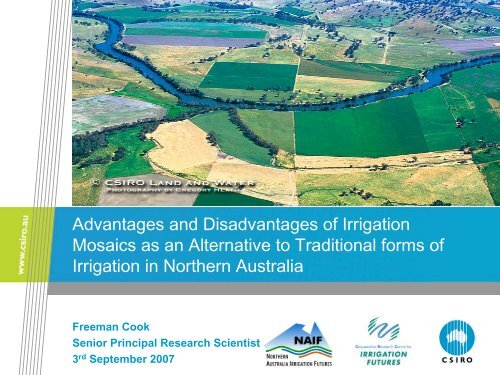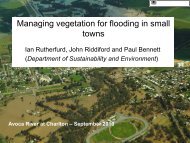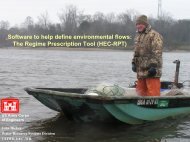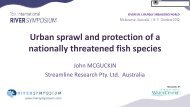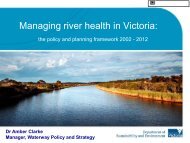Advantages and Disadvantages of Irrigation ... - Riversymposium
Advantages and Disadvantages of Irrigation ... - Riversymposium
Advantages and Disadvantages of Irrigation ... - Riversymposium
Create successful ePaper yourself
Turn your PDF publications into a flip-book with our unique Google optimized e-Paper software.
<strong>Advantages</strong> <strong>and</strong> <strong>Disadvantages</strong> <strong>of</strong> <strong>Irrigation</strong><br />
Mosaics as an Alternative to Traditional forms <strong>of</strong><br />
<strong>Irrigation</strong> in Northern Australia<br />
Freeman Cook<br />
Senior Principal Research Scientist<br />
3 rd September 2007
What are <strong>Irrigation</strong> Mosaics<br />
Rainfall<br />
Surface<br />
water<br />
ET<br />
Rainfall<br />
Surface<br />
water<br />
ET<br />
“Contiguous”<br />
“Patchiness”<br />
Coast<br />
River<br />
Unsaturated zone<br />
Bores<br />
Rootzone<br />
Unsaturated zone<br />
Coast<br />
River<br />
Unsaturated zone<br />
Bores<br />
Rootzone<br />
Unsaturated zone<br />
Groundwater system<br />
Groundwater system<br />
• Traditional irrigation systems<br />
consist <strong>of</strong><br />
• One large patch<br />
• Source from dams, bores <strong>and</strong> <strong>of</strong>ftakes<br />
<strong>of</strong>ten from existing river<br />
systems supplemented by dams<br />
• Canals <strong>and</strong> other delivery<br />
infrastructure<br />
• <strong>Irrigation</strong> <strong>of</strong> total area within<br />
scheme<br />
• Can result in undesirable<br />
environmental effects<br />
• <strong>Irrigation</strong> mosaics<br />
• Numerous small patches<br />
• Source from small dams, bores or<br />
existing river systems<br />
• Delivery infrastructure localised<br />
• Possibility to avoid irrigation <strong>of</strong><br />
unsuitable areas<br />
• It may be possible to minimise<br />
some adverse effects <strong>of</strong> irrigation<br />
CSIRO. <strong>Advantages</strong> <strong>and</strong> <strong>Disadvantages</strong> <strong>of</strong> <strong>Irrigation</strong> Mosaics as an Alternative to Traditional forms <strong>of</strong> <strong>Irrigation</strong> in Northern Australia
Why <strong>Irrigation</strong> Mosaics<br />
Rainfall<br />
Surface<br />
water<br />
ET<br />
Rainfall<br />
Surface<br />
water<br />
ET<br />
“Contiguous”<br />
“Patchiness”<br />
Coast<br />
River<br />
Unsaturated zone<br />
Bores<br />
Rootzone<br />
Unsaturated zone<br />
Coast<br />
River<br />
Unsaturated zone<br />
Bores<br />
Rootzone<br />
Unsaturated zone<br />
Groundwater system<br />
• <strong>Irrigation</strong> <strong>of</strong>ten not suitable<br />
for all areas within scheme<br />
• Water-table rise <strong>and</strong><br />
salinisation <strong>of</strong>ten problems<br />
• Lack <strong>of</strong> flexibility to respond<br />
to climatic changes<br />
• System less adaptable as<br />
large ‘sunken’ cost<br />
Groundwater system<br />
• <strong>Irrigation</strong> can avoid<br />
unsuitable areas<br />
• Water-table rise <strong>and</strong><br />
salinisation can be<br />
controlled<br />
• More flexibility to respond to<br />
climatic changes<br />
• Can use an adaptive<br />
management<br />
CSIRO. <strong>Advantages</strong> <strong>and</strong> <strong>Disadvantages</strong> <strong>of</strong> <strong>Irrigation</strong> Mosaics as an Alternative to Traditional forms <strong>of</strong> <strong>Irrigation</strong> in Northern Australia
Why Consider <strong>Irrigation</strong> Mosaics for Northern<br />
Australia<br />
• Climate is very different from Southern Australia<br />
• Opportunity to design more sustainable <strong>and</strong> environmentally sensitive<br />
developments<br />
Monthly Water Balance (mm)<br />
400<br />
200<br />
0<br />
-200<br />
Kununurra<br />
90% rain, 10% ETO<br />
Mean rain & ETO<br />
10% rain, 90% ETO<br />
Katherine<br />
Burdekin<br />
400<br />
200<br />
0<br />
-200<br />
Monthly Water Balance (mm)<br />
Jan Feb Mar Apr MayJun Jul AugSep Oct NovDec<br />
Jan Feb Mar Apr MayJun Jul AugSep Oct NovDec<br />
Jan Feb Mar Apr MayJun Jul AugSep Oct NovDec<br />
Month<br />
Month<br />
Month<br />
100<br />
Loxton<br />
Griffith<br />
Tatura<br />
100<br />
Monthly Water Balance (mm)<br />
50<br />
0<br />
-50<br />
-100<br />
-150<br />
-200<br />
90% rain, 10% ETO<br />
Mean rain & ETO<br />
10% rain, 90% ETO<br />
50<br />
0<br />
-50<br />
-100<br />
-150<br />
-200<br />
Monthly Water Balance (mm)<br />
-250<br />
Jan Feb Mar Apr MayJun Jul AugSep Oct NovDec<br />
Jan Feb Mar Apr MayJun Jul AugSep Oct NovDec<br />
Jan Feb Mar Apr MayJun Jul AugSep Oct NovDec<br />
-250<br />
Month<br />
Month<br />
Month<br />
CSIRO. <strong>Advantages</strong> <strong>and</strong> <strong>Disadvantages</strong> <strong>of</strong> <strong>Irrigation</strong> Mosaics as an Alternative to Traditional forms <strong>of</strong> <strong>Irrigation</strong> in Northern Australia
Bio-Physical Aspects<br />
• Investigation <strong>of</strong> Biophysical Properties as Related to <strong>Irrigation</strong> Patch<br />
Size<br />
• Water-table rise<br />
• Water-table spreading<br />
• Solute spreading<br />
• Evaporative dem<strong>and</strong><br />
• Can learn about all irrigation systems<br />
R<br />
CSIRO. <strong>Advantages</strong> <strong>and</strong> <strong>Disadvantages</strong> <strong>of</strong> <strong>Irrigation</strong> Mosaics as an Alternative to Traditional forms <strong>of</strong> <strong>Irrigation</strong> in Northern Australia
Water-Table Rise<br />
• The rise in the water-table above the initial level with years <strong>of</strong> irrigation.<br />
• I = 1 mm/day recharge<br />
• No sinks<br />
• No slope on aquifer<br />
400<br />
h m<br />
- h 0<br />
(m)<br />
300<br />
200<br />
100<br />
R = 100 m<br />
R = 500 m<br />
R = 1000 m<br />
R = 2000 m<br />
R = 5000 m<br />
R = 10000 m<br />
R = 100000 m<br />
Ks = 1 m/day<br />
Sy = 0.1 m 3 m -3<br />
h m<br />
R<br />
0<br />
0 20 40 60 80 100 120<br />
t (years)<br />
CSIRO. <strong>Advantages</strong> <strong>and</strong> <strong>Disadvantages</strong> <strong>of</strong> <strong>Irrigation</strong> Mosaics as an Alternative to Traditional forms <strong>of</strong> <strong>Irrigation</strong> in Northern Australia
Water-Table Rise<br />
• Spacing <strong>of</strong> the irrigation patches is critical as well as size<br />
Array <strong>of</strong> Patches<br />
1000<br />
H(ρ = 0)/H o<br />
100<br />
10<br />
τ = 0.1<br />
τ = 1<br />
τ = 10<br />
τ = 100<br />
L<br />
1<br />
0.1<br />
0 20 40 60 80 100 120<br />
n = L/R<br />
CSIRO. <strong>Advantages</strong> <strong>and</strong> <strong>Disadvantages</strong> <strong>of</strong> <strong>Irrigation</strong> Mosaics as an Alternative to Traditional forms <strong>of</strong> <strong>Irrigation</strong> in Northern Australia
Water-Table Spreading<br />
H<br />
H<br />
1e+0<br />
1e-1<br />
1e-2<br />
1e-3<br />
1e-4<br />
1e-5<br />
1e-6<br />
1e-7<br />
1e-8<br />
1e-9<br />
1e-10<br />
10<br />
1<br />
0.1<br />
0.01<br />
0.001<br />
0.0001<br />
• For single patches the area affect by water- table spreading<br />
increases as R increases.<br />
• For an array <strong>of</strong> patches the impact is increased due to overlap<br />
<strong>of</strong> the water-tables<br />
• Spacing <strong>of</strong> patches is important<br />
Single Patch<br />
Array <strong>of</strong> Patches<br />
ρ<br />
0.0 0.2 0.4 0.6 0.8 1.0 1.2 1.4 1.6<br />
τ = 1x10 -8<br />
τ = 1x10 -5<br />
τ = 1x10 -2<br />
0 10 20 30 40 50 60<br />
ρ<br />
τ = 10<br />
τ = 50<br />
τ = 100<br />
a<br />
c<br />
ρ<br />
0 2 4 6 8 10 12<br />
τ = 0.1<br />
τ = 1<br />
τ = 5<br />
0 100 200 300 400 500 600<br />
ρ<br />
τ = 500<br />
τ = 1000<br />
τ = 5000<br />
τ = 10000<br />
CSIRO. <strong>Advantages</strong> <strong>and</strong> <strong>Disadvantages</strong> <strong>of</strong> <strong>Irrigation</strong> Mosaics as an Alternative to Traditional forms <strong>of</strong> <strong>Irrigation</strong> in Northern Australia<br />
b<br />
d<br />
H(τ,ρ)<br />
H(τ,ρ)<br />
0.12<br />
0.10<br />
0.08<br />
0.06<br />
0.04<br />
0.02<br />
0.00<br />
1e+3<br />
1e+2<br />
1e+1<br />
1e+0<br />
1e-1<br />
1e-2<br />
1e-3<br />
1e-4<br />
1e-5<br />
ρ<br />
0.0 0.5 1.0 1.5 2.0 2.5 3.0 3.5<br />
L = infinity<br />
L = 2<br />
L = 2.2<br />
L = 2.5<br />
L = 5<br />
a<br />
ρ<br />
0.0 0.5 1.0 1.5 2.0 2.5 3.0 3.5<br />
1.0<br />
b<br />
ρ<br />
L = infinity<br />
L = 2<br />
L = 2.5<br />
L = 3<br />
L = 5<br />
0.01 0.1 1 10 100 10000.001 0.01 0.1 1 10 100 1000<br />
ρ<br />
L = infinity<br />
L = 2<br />
L = 2.5<br />
L = 5<br />
L = 10<br />
L = 20<br />
c<br />
L = infinity<br />
L = 2<br />
L = 5<br />
L = 10<br />
L = 20<br />
L = 50<br />
d<br />
0.8<br />
0.6<br />
0.4<br />
0.2<br />
0.0<br />
1e+3<br />
1e+2<br />
1e+1<br />
1e+0<br />
1e-1<br />
1e-2<br />
1e-3<br />
1e-4<br />
H(τ,ρ)<br />
H(τ,ρ)
Solute Spreading<br />
• For single patches<br />
• Δr = Rs – R, Rs = radius <strong>of</strong> solute spread<br />
• Solutes spread further under large patches<br />
• With correct spacing irrigation mosaics could reduce ‘pollution’ <strong>of</strong> areas outside <strong>of</strong> the<br />
irrigated region<br />
1e+5<br />
1e+4<br />
Δr (m)<br />
1e+3<br />
S1<br />
Regression S1<br />
S2<br />
Regression S2<br />
1e+2<br />
1e+1 1e+2 1e+3 1e+4 1e+5<br />
R (m)<br />
CSIRO. <strong>Advantages</strong> <strong>and</strong> <strong>Disadvantages</strong> <strong>of</strong> <strong>Irrigation</strong> Mosaics as an Alternative to Traditional forms <strong>of</strong> <strong>Irrigation</strong> in Northern Australia
Evaporative Dem<strong>and</strong><br />
• Advection – hot air from outside can lead to increased water loss for wet<br />
patches<br />
• Not a lot <strong>of</strong> data on irrigation systems but quite extensive for water bodies<br />
1<br />
f(u)/A e<br />
is the<br />
wind factor for<br />
evaporation<br />
f(u)/A e<br />
f(u)/A<br />
Regression<br />
0.1<br />
1e+1 1e+2 1e+3 1e+4 1e+5 1e+6<br />
R (m)<br />
CSIRO. <strong>Advantages</strong> <strong>and</strong> <strong>Disadvantages</strong> <strong>of</strong> <strong>Irrigation</strong> Mosaics as an Alternative to Traditional forms <strong>of</strong> <strong>Irrigation</strong> in Northern Australia
Conclusions - Specifics<br />
• <strong>Irrigation</strong> Mosaics provide an alternative to traditional irrigation<br />
schemes<br />
• <strong>Advantages</strong> <strong>of</strong> irrigation mosaics for bio-physical properties could<br />
be reduced water-table height, water-table spreading <strong>and</strong> solute<br />
spreading<br />
• These advantages are dependent on the spacing between, <strong>and</strong><br />
size <strong>of</strong> the individual patches.<br />
• We have designed some tools which give insight into design <strong>of</strong><br />
such mosaic systems<br />
• Increased evaporation is a biophysical disadvantage that has been<br />
determined<br />
• The social <strong>and</strong> economic advantages <strong>and</strong> disadvantages will need<br />
to be determined if such systems are to be adopted.<br />
CSIRO. <strong>Advantages</strong> <strong>and</strong> <strong>Disadvantages</strong> <strong>of</strong> <strong>Irrigation</strong> Mosaics as an Alternative to Traditional forms <strong>of</strong> <strong>Irrigation</strong> in Northern Australia
Conclusions - General<br />
• The principles determined in this work are applicable to existing<br />
irrigation systems as well as mosaics<br />
• They give insight into the performance <strong>of</strong> the biophysical<br />
system<br />
• For a specific area the localised conditions would have to be<br />
taken into account <strong>and</strong> other tools used in conjunction with<br />
those so far developed<br />
• There is still a lot more to do with development <strong>of</strong> analytical<br />
tools for this <strong>and</strong> related problems.<br />
CSIRO. <strong>Advantages</strong> <strong>and</strong> <strong>Disadvantages</strong> <strong>of</strong> <strong>Irrigation</strong> Mosaics as an Alternative to Traditional forms <strong>of</strong> <strong>Irrigation</strong> in Northern Australia
CSIRO L<strong>and</strong> <strong>and</strong> Water<br />
Freeman Cook<br />
Senior Principal Research<br />
Scientist<br />
Phone: 07 3214 2840<br />
Email: freeman.cook@csiro.au<br />
Web: www.csiro.au/group<br />
Thank you<br />
Contact Us<br />
Phone: 1300 363 400 or +61 3 9545 2176<br />
Email: enquiries@csiro.au Web: www.csiro.au


